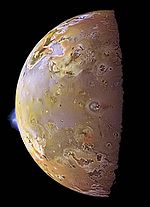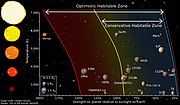Tidal heating (also known as tidal working or tidal flexing) occurs through the tidal friction processes: orbital and rotational energy is dissipated... 10 KB (1,228 words) - 08:06, 1 February 2024 |
 | Tidal heating of Io (also known as tidal working) occurs through the tidal friction processes between Jupiter and its moon. Orbital and rotational energy... 5 KB (497 words) - 15:15, 3 March 2024 |
 | Enceladus (section Tidal heating) Dione excites its orbital eccentricity, which is damped by tidal forces, tidally heating its interior and driving the geological activity. Cassini performed... 153 KB (14,776 words) - 19:28, 17 April 2024 |
 | Io (moon) (section Tidal heating) in the Solar System. This extreme geologic activity is the result of tidal heating from friction generated within Io's interior as it is pulled between... 112 KB (12,388 words) - 03:07, 26 April 2024 |
 | Exoplanet (section Tidal heating) S.; Kasting, J. F.; Heller, R. (2013). "Tidal Venuses: Triggering a Climate Catastrophe via Tidal Heating". Astrobiology. 13 (3): 225–250. arXiv:1203... 146 KB (15,828 words) - 18:56, 20 April 2024 |
 | Europa (moon) (section Tidal friction) receives thermal energy from tidal heating, which occurs through the tidal friction and tidal flexing processes caused by tidal acceleration: orbital and... 129 KB (12,665 words) - 23:44, 25 April 2024 |
 | the Sun. Tidal forces are also responsible for tidal locking, tidal acceleration, and tidal heating. Tides may also induce seismicity. By generating... 23 KB (2,817 words) - 21:20, 11 April 2024 |
Faint young Sun paradox (section Tidal heating) today, resulting in greater tidal heating than experienced today. Original estimates found that even early tidal heating would be minimal, perhaps 0.02... 30 KB (3,668 words) - 14:50, 21 April 2024 |
 | speculated that this may be the result of tectonic activity due to tidal heating. Next are the dark regions that cover about a third of Ganymede. These... 110 KB (10,543 words) - 18:17, 19 April 2024 |
 | to diffusion. Tidal forces between celestial orbiting bodies cause friction that heats up their interiors. This is known as tidal heating, and it helps... 34 KB (4,322 words) - 19:59, 6 February 2024 |
where plate tectonics is dominant. Io is exceptional for the strong tidal heating it undergoes, caused by the eccentricity of its orbit (which results... 16 KB (1,933 words) - 12:45, 19 April 2024 |
 | Tidal power or tidal energy is harnessed by converting energy from tides into useful forms of power, mainly electricity using various methods. Although... 51 KB (5,522 words) - 12:04, 10 March 2024 |
Volcanism on outer solar system moons is powered mainly by tidal heating. Tidal heating caused by the deformation of a body’s shape due to mutual gravitational... 41 KB (4,686 words) - 19:44, 25 April 2024 |
caused by gravity (the Kelvin–Helmholtz mechanism), nuclear fusion, tidal heating, core solidification (heat of fusion released as molten core material... 6 KB (891 words) - 07:49, 5 December 2022 |
 | Gliese 581c (section Tidal lock) that heating resulting from this tidal locking may play a major role in the planet's geology. Models proposed by scientists predict that tidal heating could... 36 KB (3,764 words) - 03:35, 25 March 2024 |
 | causing a varying tidal bulge. This variation in the shape of Io causes frictional heating in its interior. Without this tidal heating, Io might have been... 56 KB (6,280 words) - 22:36, 8 March 2024 |
 | these systems is the intense tidal heating caused by the short distance of planets from their host red dwarfs. Other tidal effects reduce the probability... 52 KB (6,389 words) - 16:48, 11 March 2024 |
 | Proxima Centauri b (section Tidal locking) into a non-tidally locked orbit would be possible even with low eccentricity. A non-locked orbit, however, would result in tidal heating of the planet's... 72 KB (8,144 words) - 18:12, 26 April 2024 |












